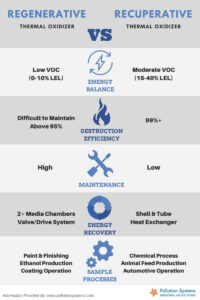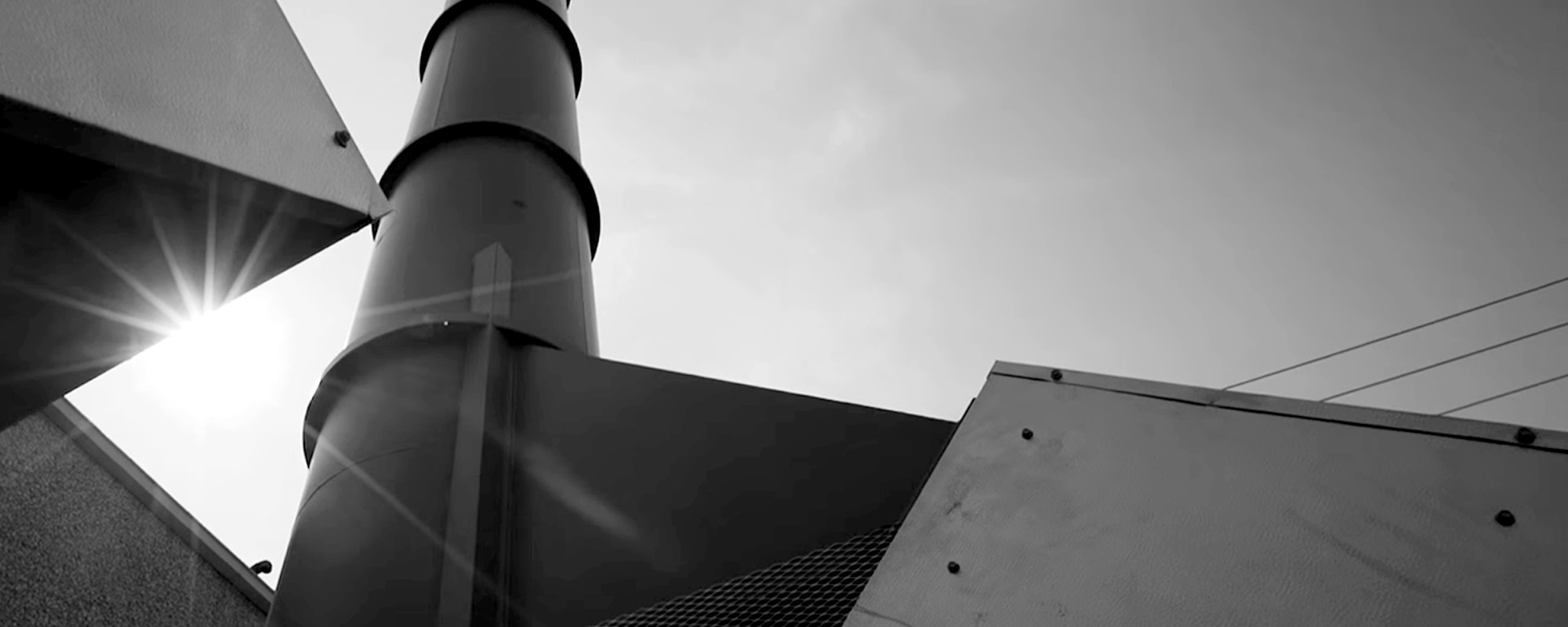Frequently Asked Questions (FAQs)
Thermal Oxidizers
Thermal oxidation is accepted in various industries as a conventional method to reduce VOC emissions, making thermal oxidizer systems popular technologies for air pollution control. However, these systems commonly get misapplied due to each oxidizer technology’s appropriateness for specific applications and process conditions. In order to choose the proper thermal oxidizer design, Pollution Systems will review the unique process challenges at hand and determine what technology is best suited for the application.
The infographic below highlights the high-level differences between regenerative and recuperative thermal oxidation:
To find more details, visit our recuperative vs regenerative technology page.
We design each air control system with the end user’s total cost of ownership in mind. We evaluate the initial capital costs, maintenance costs, and potential downtime associated with each equipment so you receive the most cost-effective solution for your application.
Enclosed Flares
Enclosed flares are capable of handling batch and continuous type operations.
Pollution Systems offers horizontal and vertical orientations for their enclosed flares, which makes them easy to integrate into an existing process that may have space limitations.
A properly designed enclosed flare should have no visible emissions, including smoke.
Catalytic Oxidizers
The sizes for these systems range from small skid-mounted units designed for a few hundred standard cubic feet per minute (SCFM) to large units capable of treating emissions greater than 10,000 SCFM.
Particulate matter (PM) covers the catalyst active site, leading to costly factory reactivation or replacement. It is critical to avoid using catalytic oxidizers on processes with particulate, heavy metals, or other poisioning agents that can permanently deactivate the catalyst in your system. View our catalyst poisons bulletin (link to document) for more details.
Catalysts used for air pollution abatement can be either structured or unstructured and they are typically either a base-metal or a precious-metal. The catalyst is usually made of a carrier (e.g. alumina), impregnated with the catalytic metal.
Wet Scrubbers
Dry dust collectors equip air filters to capture the pollutants, which require constant changing. The use of liquid in wet scrubbers allow for handling of more difficult contaminants, such as combustible dusts, sticky residues, soluble gases, and fine particulate that is too small for filter capture.
Wet scrubbers are effective for continuous and batch-type operations. Our technical team will work with you to make sure the technology selected can handle your process.
We design our scrubber systems based on the requirements of the project. Depending on the composition of the process stream, a wet scrubber can be constructed from FRP or stainless steel.
Chemical Gas Scrubbers
Scrubbers can remove many gaseous chemicals. Common chemicals include hydrogen sulfide, suflur dioxide, ammonia, chlorine, ethylene oxide, and phosphoric acid.
Our packed-bed scrubbers use engineered random packing of various materials including polypropylene, polyethylene, and PVDF for high efficiency and lower pressure drop.
Yes, chemical scrubbers are often used to treat odors. The reagent will depend on the odors being treated. For example, H2S is treated with sodium hydroxide (caustic) and sodium hypochlorite (dilute bleach).
Particulate Dust Scrubbers
If you require assistance with an existing Dust Scrubber, our dedicated technical services division, PolSys Services, can assist you in repairing or retrofitting any make and model of industrial scrubber system.
When dealing with wet, sticky buildup due to food processing residues, Multi-Vane Scrubber and Venturi Scrubber Systems are effective solutions.
Particulate Matter and dust are interchangeable. High concentrations of dust, particularly in an industrial environment, are referred to as particulate matter, and both are considered particle pollution.
The dust is collected in the sump with water. It is then sent to water treatment facilities or potentially recovered for reuse.
The baghouse uses a bag over a retaining system if it is dry, nonhazardous material. The air flows through and dust builds up on the surface area. The dust is collected as dry material. If your process has moisture, you would need a wet scrubber that can handle any liquid in the dust.
Yes, due to the health and environmental concerns associated with high concentrations of dust or particulate, the EPA regulates the emission of coarse (PM10) and fine (PM2.5) particulate matter. The Clean Air Act requires the EPA to set two types of National Ambient Air Quality Standards (NAAQS) for particle pollution, and in January 2023, announced the proposed decision to revise the primary (health-based) annual PM2.5 standard from its current level of 12.0 µg/m3 to within the range of 9.0 to 10.0 µg/m3. Visit the EPA to learn more about the current NAAQS for PM pollution.
System Features
PLC Platforms commonly used in our Controls package include Allen Bradley, Siemens, Modicon, and GE-Fanuc.
Newer PLC models offer advanced features that enable faster prediction and prevention of system issues, enhancing safe operation and compliance. These can also improve operational efficiencies and data collection, providing real-time key performance indicators for everything from PMS management to business analytics.
The control panels are constructed with the highest quality components and meet the latest NEC/UL508a standards.
If you are installing an air control system outdoors, a weather shield or hood can protect the system’s control panel from the elements.
Pollution Systems’ Automated Controls Packages are all designed and programmed by our electrical engineering department. Programming includes:
- PLC (Programmable Logic Controls) Programming
- Operator Interface Programming
- Process Controller Programming
- Telemetry (Optional)
Each control panel may include controls for
- Fan and Pump
- Industrial Burner or Electric Heater
- Temperature Control
- Fan and Motor Control
- Power Start-up/Shutdown with the push of a button
- pH Control and Chemical Metering
- Damper Control
- Chart Recorder
Aftermarket Services
Yes, we provide all of the NFPA-mandated safety interlock testing and on-site inspections for any make and model of air pollution control equipment. Please note that our aftermarket services require this for all our first-time customers.
While we do offer this service and can work remotely on almost any system, this is dependent on the remote automated controls package it may have.
Our service group offers nationwide support in the United States and, in some cases, internationally. We will inspect your system and provide a detailed report on any findings and recommendations. We inspect all parts of your system, including:
- System components
- System controls & gauges
- System temperatures
- Control Panel
- Fuel regulators
- Key parts and instruments
- Interlocks
- Monitoring devices
- Valves and Switches
- Strainers and more


